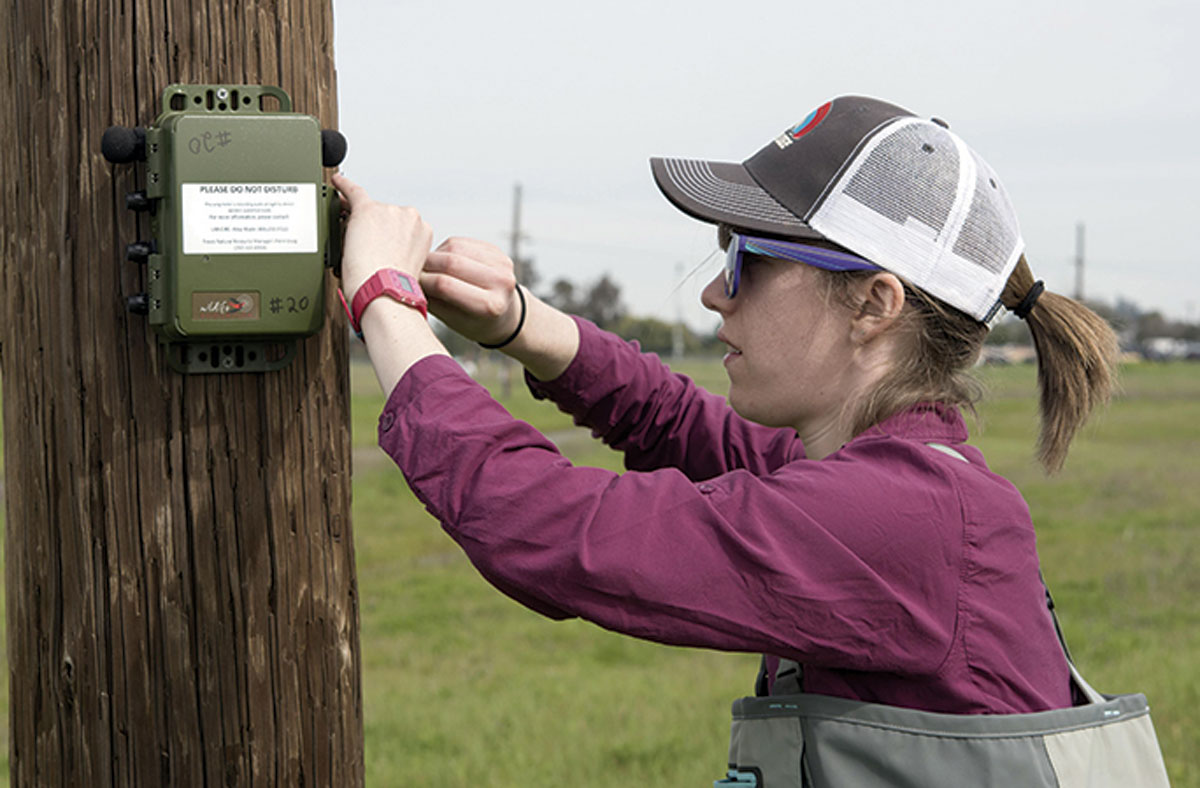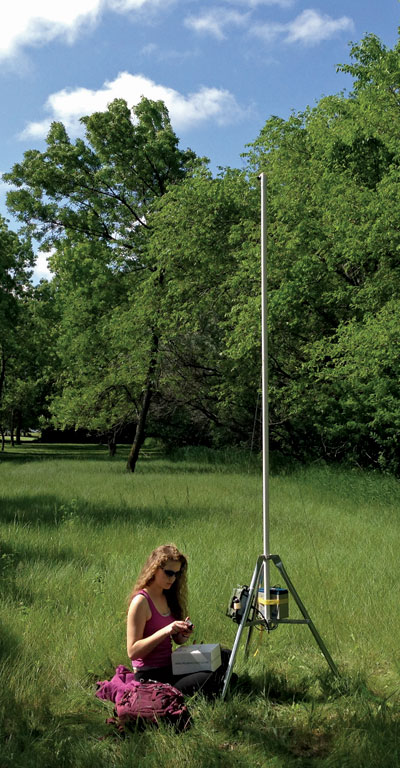- Editorial Offices
- 325 Brantly Hall
- Missoula, MT 59812
- (406) 243-2488
- themontanan@umontana.edu
- Icons By Maria Maldonado




The Oscar-01 Missile Alert Facility is a time capsule straight out of the Cold War. The first time Jeffrey MacDonald stepped into the room 35 feet below Whiteman Air Force Base, he was struck by the vision of artifacts collected over two decades following World War II. On the wall is a Bugs Bunny mural and signatures from past military personnel whose job it was to hole up inside the bunker and be prepared to launch missiles if the base was ever struck. The vault-style door, which would close the occupants inside like they were on a submarine, sports the face of Oscar the Grouch with a flip sign that says “The Grouch is in” or “out.”
“These drawings and graffiti were made to keep up spirits in a place that was very, very grave otherwise,” MacDonald says. “Once you start looking, you begin to see this military culture exemplified in their own folk art.”
Even the more functional elements of the bunker tell a story. The paint, for instance, is distinctive.
“It’s about as Stanley Kubrick as you can imagine it,” MacDonald says. “Picture that palette of sea-foam greens meeting the style of orange that only the ’60s could produce, all with perforated metal paneling. It puts you there proof-positive as to what was considered taste and fashion of the time.”
MacDonald, a UM student pursuing a doctorate in anthropology, was tasked with doing a breakdown of the facility’s rooms and systems, including doors, windows, roofing, insulation and mechanical systems. He and archaeologist Kate McCourt dissected the space down to its components and wrote a report on how to best preserve it.
This preservation work is one of more than a dozen tasks so far that the Army Corps of Engineers has contracted through the University of Montana’s Center for Integrated Research on the Environment, or CIRE (pronounced like “Siri,” Apple’s virtual assistant).
In 2014, the Corps awarded CIRE a $45 million, five-year research cooperative agreement, the largest research award in UM’s history. Over the past three years, researchers across campus – in fields ranging from anthropology to ecology – have used about $15 million of the award to complete 16 major projects on U.S. Air Force bases and ranges nationwide. The research has helped pinpoint important ecological systems and historic/prehistoric sites, making it easier for the military to follow federal regulations for preservation and conservation.
But for CIRE and the bases, it’s not just about following regulations. It’s about preserving the country’s complex heritage for generations to come. Military lands support some of the largest populations of endangered and threatened species in the country. They also are home to cultural remnants, from prehistoric Native American settlements to the first burgeoning industries of early European settlements. In addition, the military history present in buildings and on training grounds is rich with political and social significance. The Oscar-01 Missile Alert Facility, for instance, was the first such bunker to employ all-women, mixed-gender and all-black crews. That story can be documented within the details of the building.
There’s also an economic story there: All parts of the facility – all the equipment, all the building materials, all the textiles – are American made.
“Every single thing,” MacDonald says. “It was mind-blowing to see that because it makes you realize how much the American manufacturing juggernaut is gone. That, alone, makes this place interesting and important and something that needs to be interpreted.”
When it comes to historic preservation and environmental stewardship, U.S. military bases are not usually what come to mind. Still, if you think about it, it makes sense. The Department of Defense manages 38 million acres of land across the U.S., but bases have a unique quality other agency lands don’t: heavy security. They’re rarely open to the public, and, beyond some testing grounds and facilities, the lands are intact and protected.
“A lot of these places are overseeing a tremendous amount of very wild and natural places,” says Ric Hauer, CIRE director and principal investigator. “And from the natural resources perspective, the military base is actually a refuge.”
 Hauer, a UM professor of ecology, has helped build relationships between the military and the University for decades. He started working with the Army Corps of Engineers in the summer of 1992, serving on the National Science Team that developed wetland assessment procedures for Section 404 of the Clean Water Act. He has continued that relationship through CIRE, which works with the Department of Defense to solve problems in the areas of cultural and natural sciences. In 2013, UM competed against multiple universities for the cooperative agreement with the Army Corps of Engineers, and it was one of two institutions selected.
Hauer, a UM professor of ecology, has helped build relationships between the military and the University for decades. He started working with the Army Corps of Engineers in the summer of 1992, serving on the National Science Team that developed wetland assessment procedures for Section 404 of the Clean Water Act. He has continued that relationship through CIRE, which works with the Department of Defense to solve problems in the areas of cultural and natural sciences. In 2013, UM competed against multiple universities for the cooperative agreement with the Army Corps of Engineers, and it was one of two institutions selected.
There are some challenges when it comes to sending university researchers onto military bases. By necessity, the military adheres to a chain of command and a strict set of rules, running a tight ship for which projects are mapped out and executed as efficiently as possible. University culture, on the other hand, allows for more flexibility, exploration and questioning of rules. It’s the job of CIRE staff, including Hauer, to ensure the logistics of any task are ironed out ahead of time. It’s also Hauer’s job to help blend university and military cultures as seamlessly as possible.
“Security is a really, really big deal on the bases,” Hauer says. “You can’t be taking pictures of the airplanes no matter how cool they look. It’s more restrictive than the freedom-of-information approach at the university. The military likes very specific time frames on things, so they like their projects to run like Swiss trains.”
At the same time, the confluence of military and university culture creates a powerful complementary relationship. In particular, UM offers a breadth of exploration that other sources of research don’t.
“University researchers are first and foremost interested in doing scholarship,” Hauer says. “Within that scholarship, we do things that are extremely high-end in terms of knowing the kinds of questions to ask and the most contemporary methods on how a project gets executed and results interpreted.”
Two projects CIRE currently is tackling involve asking big questions about bats. While plenty of bat research happens at universities, these projects will look at the impact of military operations on bat populations – especially those that are endangered. So far, CIRE researchers have looked at 14 bases and soon will expand to 48 more across the U.S., from North Dakota to Texas and Cape Cod to California. Hauer says this kind of project provides the military with a meaningful, in-depth study and researchers with worthwhile experience.
“Learning is not just learning in the classroom – it’s experience,” Hauer says. “It’s expanding one’s knowledge and understanding to actually develop and have a robust career.”
At Avon Park Air Force Range, UM archaeology Professor Douglas MacDonald and other UM researchers found a site where Native Americans lived 11,000 years ago. They carried out several excavations uncovering stone tools, such as fluted projectiles that are uniquely linked to Paleoindians. At a New Jersey Air National Guard base, MacDonald says they discovered collier huts where charcoal producers in the 19th century would spend three or four weeks at a time. The charcoal they made would be used in rum production and hide tanning for leather manufacturing, among other things.
“You’d have people going into the woods of the Pine Barrens and building pit houses and making temporary wood structures that are really hard to find because they’re temporary, and most of them have gone away,” MacDonald says.
Cataloging objects takes different forms, depending on the military base or range. On the Avon Range in Florida, the CIRE crew collected artifacts, analyzed them and then processed them so they could go back to the range for museum use. In other places, like on a base in Nevada, the archaeologists will not be allowed to touch anything. They’ll just be asked to map out the archaeology of the area.
“We have Native American escorts out there who will be helping us see landscape features that we don’t have experience in,” MacDonald says. “And they’d be able to interpret these archeological resources in different ways than we would.
“Pretty much everywhere we’ve gone we’ve found interesting archaeology,” he adds. “It’s been a good experience. You can do a survey and not find anything, so it’s always fun to encounter interesting history and prehistory.”
To compare, the Department of Defense owns only about one-eighth of the land area that the U.S. Forest Service manages, but it supports just as many threatened and endangered species. In 1960, the Sikes Act was created to ensure that wildlife and other natural resources on military lands would be protected and enhanced.
“There is amazing potential on military lands for protecting species and restoring their habitat conditions,” says Cara Nelson, UM associate professor of restoration ecology and CIRE principal investigator. “Military lands include some of the most intact ecosystems that we have in the United States.”
Ecological restoration – repairing degraded ecosystems – has become an increasingly important mission.
“Globally, we spend $3 trillion per year on restoration projects,” Nelson says. “And that is a conservative estimate.”
The problem is, in order to maximize this investment in restoration, there is a need to better integrate science into practice.
“Restoration has an incredible potential to improve both ecological conditions and human well-being,” she says. “But success hinges on using ecologically appropriate methods, which doesn’t always happen.”
Last summer, Florida’s Homestead Air Reserve Base contracted CIRE to survey its land for four species. Two were plants: Carter’s small-flowered flax and the Florida brickell-bush, and two were butterflies: Bartram’s Scrub-hairstreak and Florida Leafwing. They recently were added to the federal endangered species list because their habitat, open pine rockland, occurs at slightly higher elevations than the surrounding wetlands, and over the years it has been developed. This development has been an important factor in the habitat’s demise, but so has fire. Wherever there’s human development, there’s fire suppression, and pine rockland is disturbance-dependent: It needs fire to thrive.
UM student Kenda Herman and research scientist Megan Keville, who both work in Nelson’s Restoration Ecology Lab, are studying some of the last remnant patches of open pine rockland habitat that have been protected at Homestead and the effect of fire exclusion on these habitats. The lab has conducted a series of investigations on the effects of fire suppression on understory plants and ecological communities in western forests. The CIRE project offered the Montana team a new landscape to explore ideas about the influence of fire and its suppression on biodiversity.
“I thought it was really important as a student of ecology to have the opportunity to research a system that was different from ones I am familiar with,” Keville says. “It forced me to look at ecological problems from a bigger picture. I think it’s equipped me to be a better scientist and ecologist.”
In addition, Herman was able to use the opportunity to develop a master’s thesis related to the conservation of pineland croton – the plant that is the host for the two endangered butterflies. These butterflies no longer occur on the base, but by studying the host plant, Herman aims to contribute to the conservation of butterflies. She also experimented with disturbance techniques, namely mowing, to act as a fire surrogate to see if that could help restore the pine rockland habitat.
“We added project elements that would not have been likely with contractors outside of an academic institution,” Nelson says. “In addition to conducting the basic surveys, we also tested the efficacy of the survey methods. In addition, Kenda’s work is using the survey data to predict whether populations of pineland croton will increase or decline over time.
“I think the university can play an important role in developing natural resource monitoring programs for military lands,” she adds. “And that’s super important because of the key role of these lands for conserving biodiversity.”
This summer, several CIRE researchers, including Doug MacDonald and Jeff MacDonald, will travel to Cheyenne Mountain Complex in Colorado Springs. It’s the site of the North American Air Defense Command (NORAD) control center, a base that was dug into a granite mountain during the Cold War. They’ll take a look at the historical engineering of the site and provide a preservation assessment.
“Working with CIRE has taken me to some of the most fascinating destinations I have ever seen,” Jeff MacDonald says. “And I’ve worked all over the world. These are, far and away, some of the more incredible resources anywhere.”
Hauer is pleased with the new relationship between UM and the Army Corps of Engineers, and he predicts the number of contracts will continue to increase. For UM, these projects with the Department of Defense will play an important role in staying on the forefront of ecological and anthropological research. UM’s work with the Corps of Engineers, as cooperative partners, will add to the preservation and conservation enterprise in the nation.
“The research we are doing is important for both cultural and natural resources,” Hauer says. “In the area of cultural resources, it helps the federal government – who is actually us – as a nation, maintain our cultural heritage. In the area of natural resources, it helps us maintain our natural heritage, from endangered species to forest management. What we do in these realms is good for us, but also really good for the country.”